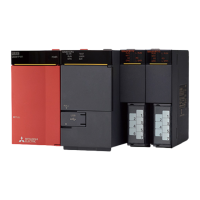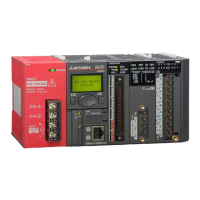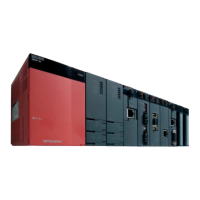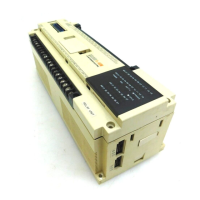11 - 4
11.2 Periodic Inspection
11
MAINTENANCE AND INSPECTION
11.2 Periodic Inspection
The items that must be inspected one or two times every 6 months to 1 year are listed
below.
When the equipment is moved or modified, or layout of the wiring is changed, also perform
this inspection.
Table11.2 Periodic Inspection
Item Inspection Item Inspection Judgment Criteria Remedy
1
Ambient environment
Ambient temperature
Measure with a
thermometer and a
hygrometer.
Measure corrosive gas.
0 to 55
When the sequencer is
used in the board, the
ambient temperature in the
board becomes the
ambient temperature.
Ambient humidity 5 to 95 %RH
Atmosphere
Corrosive gas must not be
present.
2 Power voltage
Measure a voltage across
the terminals of 100/
200VAC.
85 to 132VAC
Change the power supply.
170 to 264VAC
3
Installation
Looseness, rattling
Move the module to check
for looseness and rattling.
The module must be
installed fixedly.
Retighten the screws.
If the CPU, or power
supply module is loose, fix
it with screws.
Adhesion of dirt and
foreign matter
Check visually.
Dirt and foreign matter must
not be present.
Remove and clean.
4
Connection
Looseness of terminal
screws
Try to further tighten screws
with a screwdriver.
Screws must not be loose.
Retighten the terminal
screws.
Proximity of solderless
terminals to each other
Check visually.
Solderless terminals must
be positioned at proper
intervals.
Correct.
Looseness of
connectors
Check visually.
Connectors must not be
loose.
Retighten the connector
fixing screws.
5Battery
Check "BAT." LED on the
front face of the CPU
module.
The LED must be Off.
If the LED is On, replace
the battery.
Check the period after the
purchase of the battery.
The period must be five
years or less.
If the battery is used for
more than 5 years, replace
the battery.
Check in the monitoring
mode of GX Developer that
SM51 or SM52 is turned
OFF.
SM51 or SM52 must be
OFF.
If SM51 or SM52 is ON,
replace the battery.
6
Number of writes to
standard ROM
Check the values of SD232
and SD233 in the monitoring
mode of GX Developer.
The number of writes to the
standard ROM must be
100,000 times or less.
If the number of writes to
the standard ROM
exceeds 100,000 times,
replace the CPU module.
7 Clock
Check the current time at
the clock setting of GX
Developer.
There is no time lag
between the time checked
at the time setting of GX
Developer and the actual
time.
Change the time at the
time setting of GX
Developer.

